| Author |
Message |
|
Stephen Curtin
|
 Posted: Mon 07 Nov, 2016 1:31 am Post subject: Posted: Mon 07 Nov, 2016 1:31 am Post subject: |
 |
|
Well the Gokstad shields most likely did have some kind of rim, but I think that they were probably made from organic material. If they were iron rimmed, then I think that there would be some evidence as the iron bosses survived.
Although the sagas were based on an earlier oral tradition, they weren't written down until the 13th. So it's possible that the iron rims could be a later addition.
Also the Norwegian laws concerning what arms a man should own mention that shields should have 3 iron bars on the back, but no mention of an iron rim.
Éirinn go Brách
|
|
   |
 |
Dan Howard

|
 Posted: Mon 07 Nov, 2016 3:29 am Post subject: Posted: Mon 07 Nov, 2016 3:29 am Post subject: |
 |
|
| Stephen Curtin wrote: | | Well the Gokstad shields most likely did have some kind of rim, but I think that they were probably made from organic material. If they were iron rimmed, then I think that there would be some evidence as the iron bosses survived.. |
So where are the nails that were used to attach the rim? If the iron nails did not survive, why should the rim?
| Quote: | | Also the Norwegian laws concerning what arms a man should own mention that shields should have 3 iron bars on the back, but no mention of an iron rim. |
What does a Norwegian law have to do with Danish or Swedish or Icelandic shields? Even if Norwegian shields didn't have an iron rim, that doesn't mean that other shields didn't have one.
Author: Bronze Age Military Equipment, Pen and Sword Books
|
|
  |
 |
|
Niels Just Rasmussen
|
 Posted: Mon 07 Nov, 2016 6:53 am Post subject: Posted: Mon 07 Nov, 2016 6:53 am Post subject: |
 |
|
| Stephen Curtin wrote: | | I believe it was fellow forum member Elling Polden who once said that that the use of bucklers by Scandinavians of the 13th, weren't typically not used in battle, but were more used by bodyguards and the like. If I'm misremembering what you said Elling, my apologies. I don't know if this is true or not, but I do know that even in the 13th Norwegian infantry stil fought in a shieldwall formation. This is mentioned in The King's Mirror written in about 1250. Now by this time the kite/heater shield had taken the place of the large round shields of the Viking Period. I believe that kite shields were introduced into the Scandinavian lands some time in the 11th century, and for a time were used alongside the old large round shields. As far as I know kite had completely replaced large round shields by the time of Giraldus' writings. So why does Giraldus mention round shields? As I said I believe these to be bucklers, like the one I attached to my last post. So why would the Norsemen in Ireland be using bucklers instead of the larger kite/heater shields which were typically used at this time? Well I believe that this might have been a response to the conditions in Ireland. In Ireland skirmishes and raids were far more common than pitched battles. The Irish themselves used shields very much like a "viking shield" only smaller, essentially bucklers. My thought is that the Norsemen in Ireland preferred bucklers to larger kite shields as this better suited the combat style that was most useful in that country. |
I think it is important to distinguish between professional warriors (viking as profession and hird/huscarl warriors) which would likely have the newest up to date equipment and the drafted-for-campaign (leding) free farmers, which supplied their own weaponry. The free farmers would have shield + sword and/or axe, so here we can definitely expect round shields quite far up in time. As farmers had to provide their own equipment it was probably also produced fairly locally, whereas the viking & hird/huscarl warriors could have equipment from vastly different geographical areas.
I would hypothesis that its first when you have a substantial amount of german craftsmen in the Scandinavian towns, who really starting to pop up everywhere in Scandinavia beginning around ~1100 and really becoming town dominant in the ~1300's (especially Hansa merchants), that the transition from viking age- to middle age equipment would have ended within "leding" armies. Thus ~1100-1300 AD would be a gradual transition period between viking and middle age outlook of a Scandinavian leding army. Likely Denmark was affected earliest and people living close to major trading town in Norway and Sweden with german merchants (Bergen, Stockholm) would have access to the new than the more inland population.
You had to arrive with a shield - so far as I remember the Scandinavian landscape laws don't specify its shape or size.
So how this transition would be working around within communities of Norwegian, Danish and Norse-Gaels people in Shetland, Orkney, Scotland and Ireland is quite interesting.
Conservatism in contrast to new "Medieval" influx from the continent:
Hansa influence from Bergen in Norway to the Western Norse.
Influence from England? (Both domestic english and german merchants moving to England and the ideas going west?)
Focus on own specialization? - the Irish through time had weapon specializations within their own "conservative" guerrilla style of fighting. That influence could also greatly influence the local Scandinavians.
|
|
  |
 |
|
Sean Manning
|
 Posted: Mon 07 Nov, 2016 8:30 am Post subject: Posted: Mon 07 Nov, 2016 8:30 am Post subject: |
 |
|
| Håvard Kongsrud wrote: | | Sean Manning wrote: | If you want to get into the details of the original text and the different versions, you will need to find a Latin edition with an apparatus criticus (notes in the margins telling you what the individual manuscripts actually say) and a discussion of what the different Middle English translations are based on (it might be a surviving manuscript, it might be several, it might be a text which does not survive in Latin).
Your quote from Nat. Lib. of Ireland, MS 700 says that the invaders were "warlike men in the Danish style, dressed all over in iron, some with long loricae <the "normal" kind of mail body armour in the author's world, which is different in Wales in 1171 than in Cologne in 1271 or Naples in 1371>, some with iron lames artfully sewn together, and also with round red shields, reinforced all about with iron, men just as iron in their hearts as in their arms, in ordered battalions." |
Thank you for your translation, Sean! Nat. Lib. MS 700 seem to be first or second edition. Furnivall 1896, and Dimock 1867 are to an extent such texts for the middle english and two first latin editions respectively. I was hoping Scott & Martin's 1978-translation could give some clues to more recent works, but alass. I'm unable to get my hands on it. |
I am glad to help. Unfortunately, demand to really look closely at these texts is not very big ... so if they print them (which was the only option in 1978) the print run is usually small and the copies are expensive. On the bright side, there is lots of room for anyone willing to learn a medieval language or two to find things which 'arms and armour' people have never heard of, even just using free online sources like Codecs.
It looks like you have a version of the Latin text with a basic apparatus on page 264 of Dimock's edition so I would use that and not worry too much about the later translations.
|
|
  |
 |
|
Stephen Curtin
|
 Posted: Mon 07 Nov, 2016 10:57 am Post subject: Posted: Mon 07 Nov, 2016 10:57 am Post subject: |
 |
|
| Dan Howard wrote: |
So where are the nails that were used to attach the rim? If the iron nails did not survive, why should the rim? |
Who said anything about nails, the rim could have been stitched on with organic material.
| Dan Howard wrote: |
What does a Norwegian law have to do with Danish or Swedish or Icelandic shields? Even if Norwegian shields didn't have an iron rim, that doesn't mean that other shields didn't have one. |
True. The Gulatinglaw and Frostatinglaw both come from Norway. Similar laws might have existed in other Norse lands, but unfortunately I haven't come across any. It turns out I was wrong when I said that bucklers were the only Scandinavian shields that we know for sure had iron rims. Another Norwegian law from the second half of the 13th century mentions shields with iron rims as well as 3 iron bars. So in 10th century Norway shields were required to have 3 iron bars, and by the 13th century 3 iron bars and an iron rim were required.
| Niels Just Rasmussen wrote: |
I think it is important to distinguish between professional warriors (viking as profession and hird/huscarl warriors) which would likely have the newest up to date equipment and the drafted-for-campaign (leding) free farmers, which supplied their own weaponry. The free farmers would have shield + sword and/or axe, so here we can definitely expect round shields quite far up in time. As farmers had to provide their own equipment it was probably also produced fairly locally, whereas the viking & hird/huscarl warriors could have equipment from vastly different geographical areas. |
Kite shields had been used in Norse lands for over 100 years by the time of Giraldus' writings. Sure old fashioned equipment would have been used by the less wealthy, but I think that 100 years is enough time for even the poorest men eligible for military service to start using kites.
Éirinn go Brách
|
|
   |
 |
|
Stephen Curtin
|
 Posted: Mon 07 Nov, 2016 2:03 pm Post subject: Posted: Mon 07 Nov, 2016 2:03 pm Post subject: |
 |
|
I forgot to bring this up earlier, but there is a president for Norsemen in Ireland adopting smaller "Irish style" shields. There are examples of shield bosses excavation from Dublin that don't match any from "Viking" burials found in other countries, instead they match bosses found in a native Irish context.
Éirinn go Brách
|
|
   |
 |
Dan Howard

|
 Posted: Mon 07 Nov, 2016 2:31 pm Post subject: Posted: Mon 07 Nov, 2016 2:31 pm Post subject: |
 |
|
So how can you tell whether these Irish bosses came from small or large shields?
Author: Bronze Age Military Equipment, Pen and Sword Books
|
|
  |
 |
|
Niels Just Rasmussen
|
 Posted: Tue 08 Nov, 2016 6:43 am Post subject: Posted: Tue 08 Nov, 2016 6:43 am Post subject: |
 |
|
| Stephen Curtin wrote: |
| Niels Just Rasmussen wrote: |
I think it is important to distinguish between professional warriors (viking as profession and hird/huscarl warriors) which would likely have the newest up to date equipment and the drafted-for-campaign (leding) free farmers, which supplied their own weaponry. The free farmers would have shield + sword and/or axe, so here we can definitely expect round shields quite far up in time. As farmers had to provide their own equipment it was probably also produced fairly locally, whereas the viking & hird/huscarl warriors could have equipment from vastly different geographical areas. |
Kite shields had been used in Norse lands for over 100 years by the time of Giraldus' writings. Sure old fashioned equipment would have been used by the less wealthy, but I think that 100 years is enough time for even the poorest men eligible for military service to start using kites. |
The reason for my hypothesis that you could have leding drafted personal with more old school equipment was the image provided from this thread - which I finally found again.
Source: http://myArmoury.com/talk/viewtopic.php?t=32574&highlight=
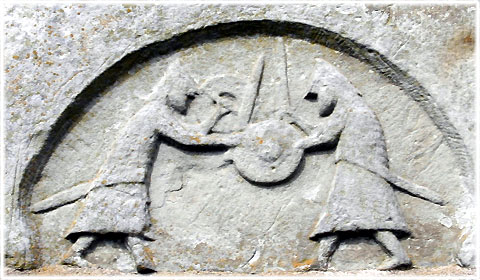
This image from a church on Gotland (Grötlingbo kyrka) from the late 12th century/early 13th century apparently shows a duel with round shields - interestingly enough fairly small round shields. Also still have "norman helmets".
Source: http://www.guteinfo.com/scripts/bilder/info/185_3.jpg
Another picture from the same church shows a riding knight with a kite shield - so the artist's choice of shields seems quite deliberate.
It is by all likelihood a carving made by Master Sighraf - work found on Bornholm, Scania, Sweden and Gotland - who signed his name with runes (in Gutnish, so he is definitely from Gotland) on his work at Å church (modern Åkirkeby) on Bornholm.
Source: https://en.wikipedia.org/wiki/Sigraf
Granted the ritualistic aspects of duels could have meant that traditional round shields was in much longer use, than on the battlefield, but it is interesting nonetheless. Some free farmers could have been conservative and showed up with round shields instead of kite shields when call on a "leding".
By the way which Norwegian law did you find the mention of iron rimes on shields were demanded for the leding crews?
|
|
  |
 |
|
Stephen Curtin
|
 Posted: Tue 08 Nov, 2016 4:25 pm Post subject: Posted: Tue 08 Nov, 2016 4:25 pm Post subject: |
 |
|
| Dan Howard wrote: | | So how can you tell whether these Irish bosses came from small or large shields? |
Well there isn't much to go on, but images of Irish warriors of this time all show small shields. I know artistic evidence isn't always 100% accurate. Other than that there is an iron shield grip in the National Museum of Ireland which appears to have come from a small round shield. There might be more archaeological evidence out there, off the top of my head I don't remember. Now its also possible that the Norsemen adopted "Irish style" shield bosses while still using large round shields.
| Niels Just Rasmussen wrote: | | Granted the ritualistic aspects of duels could have meant that traditional round shields was in much longer use, than on the battlefield, but it is interesting nonetheless. Some free farmers could have been conservative and showed up with round shields instead of kite shields when call on a "leding". |
I agree with you, in the sense that, I wouldn't rule out the possibility of large round shields continuing on in use up until fairly late, but I'd say that the men in this carving are using bucklers and not the traditional "viking" round shields.
| Niels Just Rasmussen wrote: | | By the way which Norwegian law did you find the mention of iron rimes on shields were demanded for the leding crews? |
Here is where I found the reference
http://myArmoury.com/talk/viewtopic.php?t=32114&highlight=
Its in a post by Baard H concerning the Landlaw of Magnus Lagabøte.
Éirinn go Brách
|
|
   |
 |
|
Niels Just Rasmussen
|
 Posted: Wed 09 Nov, 2016 7:10 am Post subject: Posted: Wed 09 Nov, 2016 7:10 am Post subject: |
 |
|
| Stephen Curtin wrote: |
| Niels Just Rasmussen wrote: | | By the way which Norwegian law did you find the mention of iron rimes on shields were demanded for the leding crews? |
Here is where I found the reference
http://myArmoury.com/talk/viewtopic.php?t=32114&highlight=
Its in a post by Baard H concerning the Landlaw of Magnus Lagabøte. |
Thanks Stephen.
I just give the law here again:
Landlaw of Magnus Lagabøte (1274-76) - just to remember that is 100 years after the description of 1171..
Chapter 11. On weapon-outfit
1. The man who owns six weighted marks except his clothes, he shall own a red shield with a double-sided iron rim and spear and sword or half-thinned axe. But the man who owns twelve weighted marks except his clothes, he shall own a shield and steel-cap in addition to the aforementioned weapons.
2. And every shield-maker shall on the shields he make have a mark that is approved on the thing so that you can know who made it if there is found cheating in it; but if some does not have, then the shields are confiscatable by the kings hand.
3. But the man who owns 18 weighted marks except for his clothes, he shall own a shield and steel-cap and panzer or maille and all the people’s arms. But if someone lack these weapons, then he shall pay the fine of one øre silver to the king for each missing.
4. But every young man and those men who owns less goods than now is said, each of these shall own a shield and spear or sword or axe. But broad-axes are good and half-thinned axes who is well hafted and those spears that are dependably hafted and equipped with two nails or at least one who goes straight through and is riveted in both ends. Good shall for these men wooden shields be, when three iron bars lay across it and there is three grips on the inside, who is well riveted.
5. But when a working man takes his first service for full wages, then he shall the first summer buy an axe, the second a shield and the third a spear. But if he lacks any of these three weapons, then he shall pay fine to the king of one øre for every one he lacks. But if he lacks them all, then he shall pay fine of one øre to the king and have only half-rights until he get hold of weapons.
So in 1) red (!) double sided iron rimmed shields for the richer farmers,
whereas in 4) the younger men and/or poorer farmers can make do with wooden shields with three iron bars across it (?)
It very interesting that the shields have to be marked acknowledged by the local "ting" (2), which probably could point to domestic construction (perhaps also famous foreign marks).
|
|
  |
 |
|
Stephen Curtin
|
 Posted: Wed 09 Nov, 2016 10:21 am Post subject: Posted: Wed 09 Nov, 2016 10:21 am Post subject: |
 |
|
| Niels Just Rasmussen wrote: | | It very interesting that the shields have to be marked acknowledged by the local "ting" (2), which probably could point to domestic construction (perhaps also famous foreign marks). |
To me the makers marks suggests that shield making was a professional trade.
Éirinn go Brách
|
|
   |
 |
|
Mark Moore
|
 Posted: Wed 09 Nov, 2016 11:17 am Post subject: Posted: Wed 09 Nov, 2016 11:17 am Post subject: |
 |
|
I've been following this topic loosely, as my knowledge of the subject is limited, but I will chime in: I'm sure that shields, as well as all other weapons would have to be approved and rated as 'battle-ready', the same as we rate them today. Such items would have to be tried and proven. If they get a kings high marks, then....well....enough said. If it's good enough for the king, then.........Just my two pence.......McM
''Life is like a box of chocolates...'' --- F. Gump
|
|
  |
 |
|
Håvard Kongsrud
|
 Posted: Wed 09 Nov, 2016 1:25 pm Post subject: Posted: Wed 09 Nov, 2016 1:25 pm Post subject: |
 |
|
Thank you for your socratic guestioning, Dan. Niels, you do have the superpower of speculation, but you bring forth some very interesting sources too. And you too, Stephen.
A note: The reference in Baards post to "a double-sided iron rim" is a 19th century mistranslation. The extant manuscripts (going back to the early 14th century) reads "hann skal eiga skiolld rauðan tuibyrðan [or tuibyrðing]". The term "tuibyrðan" is also used to describe lined tunics or cloaks. Allready Hjalmar Falk (1914:9) corrected it by removing the reference to "iron rim". Interestingly, in one of the versions of the text, called the Eidsvoll E-version, it only states "han skal æiga linda skiold" (he shall own a linden shield). Anyway, it is most likely a reference to shields laminated in one way or another.
Yes, the reference to a maker's mark clearly point to domestic professional shield makers. In Bergen their prices for shields and bucklers were regulated in 1282. In the mid 13th century at the latest they had a street near the royal castle pointed out for them. There is no reason to believe that the profession was new in Bergen at that time.
|
|
  |
 |
|
Stephen Curtin
|
 Posted: Wed 09 Nov, 2016 2:17 pm Post subject: Posted: Wed 09 Nov, 2016 2:17 pm Post subject: |
 |
|
Ah thanks for clearing up the mistranslation Håvard. So it turns out I was right when I said that bucklers are the only type of shield that we know for certain (sometimes) had iron rims.
Éirinn go Brách
|
|
   |
 |
|
Niels Just Rasmussen
|
 Posted: Thu 10 Nov, 2016 3:37 am Post subject: Posted: Thu 10 Nov, 2016 3:37 am Post subject: |
 |
|
| Håvard Kongsrud wrote: | Thank you for your socratic guestioning, Dan. Niels, you do have the superpower of speculation, but you bring forth some very interesting sources too. And you too, Stephen.
A note: The reference in Baards post to "a double-sided iron rim" is a 19th century mistranslation. The extant manuscripts (going back to the early 14th century) reads "hann skal eiga skiolld rauðan tuibyrðan [or tuibyrðing]". The term "tuibyrðan" is also used to describe lined tunics or cloaks. Allready Hjalmar Falk (1914:9) corrected it by removing the reference to "iron rim". Interestingly, in one of the versions of the text, called the Eidsvoll E-version, it only states "han skal æiga linda skiold" (he shall own a linden shield). Anyway, it is most likely a reference to shields laminated in one way or another.
Yes, the reference to a maker's mark clearly point to domestic professional shield makers. In Bergen their prices for shields and bucklers were regulated in 1282. In the mid 13th century at the latest they had a street near the royal castle pointed out for them. There is no reason to believe that the profession was new in Bergen at that time. |
Hej Håvard.
Is superpower of speculation good or bad  [just to know its hypothesis and not facts I toss around here]. [just to know its hypothesis and not facts I toss around here].
Great with getting the original formulation of the law, though interesting with the changes between tuibyrðing and tuibyrðan
So some speculation about this word: [hopefully someone with more expertise in Old Norwegian can chime in]
1) If a substantive:
Figured out that a "byrðings-maðr" is a sailing/traveling salesman - with byrðing meaning a cargo ship (presumingly more medieval in style than a viking age Knörr ?!).
Source: http://onpweb.nfi.sc.ku.dk/webart/b/by/12657art.htm
Source: http://onpweb.nfi.sc.ku.dk/webart/b/by/12655art.htm
So they word has clear connotations to merchants and ships.
Byrði also means the side of the ship (bord in Danish).
Source: http://onpweb.nfi.sc.ku.dk/webart/b/by/12653art.htm
The last meaning "board" probably is the reason for the translation of tui-byrðing with "two board(-layers)".
2) If a verb in origin (converted into a noun):
You have byrða which means "provide with a protective covering" or make a decoration border/tapestry.
Source: http://onpweb.nfi.sc.ku.dk/webart/b/by/12645art.htm
Source: http://onpweb.nfi.sc.ku.dk/webart/b/by/12646art.htm
I'm a bit perplexed with the tui- (or is it "tu ibyrðan"?)
A) If "tui"- means two (but that's not normal, is it?, should be tveir) -> then the two board explanation probably works the best. Also with the other linden shields mentioned.
B) If it is Tu (þū) + ibyrðan then its "you" as a personal pronoun -> doesn't really make sense in the full sentence.
Unless it is a short statement in itself "You shall carry (these)". Byrde in modern Danish means something you carry (and Byrd is your genealogy you "carry" around).
C) Could "tui" be a Norwegian equivalent to modern Danish "tøj", which is loaned from Low German "tuch".
With the Hansa present at Bergen as merchants that is a distinct possibility.
Tøj in Danish means originally something of textile being worn and/or being protective -> meaning of "clothes", "bedding" and also "armour".
So tui- (= clothes, covering, protecting) + -byrðan (= covering, decoration) then we do seem to have a textile covering of the shield possibly decorated around the edges! So a covering of the shield edges (most likely not of metal, though Tøj in Danish at least later also means metal armour).
The first and second part Tui + byrðan then has in this composite word almost the same meaning.
So marks of Bergen "shielders" (or what that craft is called) that has been approved by the "ting" definitely shows a kind a craft specialization (some could off course be "semi-pro" and not full time occupants as a "leding" wasn't called all the time).
Last edited by Niels Just Rasmussen on Thu 10 Nov, 2016 6:33 am; edited 2 times in total
|
|
  |
 |
|
Niels Just Rasmussen
|
 Posted: Thu 10 Nov, 2016 3:58 am Post subject: Posted: Thu 10 Nov, 2016 3:58 am Post subject: |
 |
|
| Mark Moore wrote: | | I've been following this topic loosely, as my knowledge of the subject is limited, but I will chime in: I'm sure that shields, as well as all other weapons would have to be approved and rated as 'battle-ready', the same as we rate them today. Such items would have to be tried and proven. If they get a kings high marks, then....well....enough said. If it's good enough for the king, then.........Just my two pence.......McM |
Hi Mark.
It is the local "ting" who has to approve the shields (having the right marks). So not really in domain of the King, but the local assemblages who made the quality choices.
Off course if the King got a shield with a certain mark it would probably make other rich people interesting in getting the same, but you also had a lot of poor farmers who had to acquire cheaper shields (but still those with approved marks).
|
|
  |
 |
|
Lafayette C Curtis
|
 Posted: Mon 19 Dec, 2016 11:57 am Post subject: Posted: Mon 19 Dec, 2016 11:57 am Post subject: |
 |
|
|
"Lamina" implies a fairly thin object somewhat longer than it is broad -- think of sword blades and the like (lame still means "blade" in some contexts in French). I'd say it's a fair description of the small plates that would have been used in the construction of a reinforced surcoat or early coat-of-plates.
|
|
  |
 |
|
Baard H
|
 Posted: Wed 22 Feb, 2017 5:47 am Post subject: Posted: Wed 22 Feb, 2017 5:47 am Post subject: |
 |
|
Thought I should chip in a little as well. Very interesting post so far and nice to know my earlier contribution to this forum is still valuable (although a little obsolete in the translation).
Here's a shield found in Trondheim from the late 11th century. Its size was around 50 by 100 cm. Two layers of planks going across each other and originally covered in leather I believe.
 Attachment: 86.89 KB Attachment: 86.89 KB
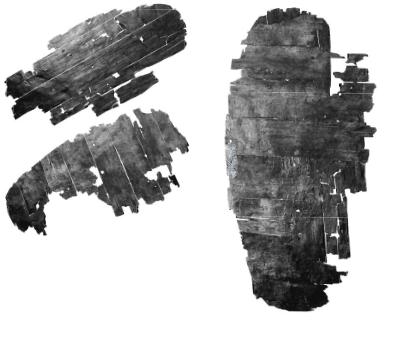
At kveldi skal dag leyfa,
konu, er brennd er,
mæki, er reyndr er,
mey, er gefin er,
ís, er yfir kemr,
öl, er drukkit er.
-Hávamál, vísa 81
|
|
  |
 |
|
Stephen Curtin
|
 Posted: Thu 23 Feb, 2017 12:00 am Post subject: Posted: Thu 23 Feb, 2017 12:00 am Post subject: |
 |
|
Thanks for sharing these images Baard.
Éirinn go Brách
|
|
   |
 |
|
Håvard Kongsrud
|
 Posted: Sat 04 Mar, 2017 1:59 pm Post subject: Posted: Sat 04 Mar, 2017 1:59 pm Post subject: |
 |
|
Thanks for chiming in, Baard!
I thought I'd just crosspost these Norwegian iron age iron rims here, Curtin.
| Håvard Kongsrud wrote: | .
Fragment of iron age iron rim and handle C5151
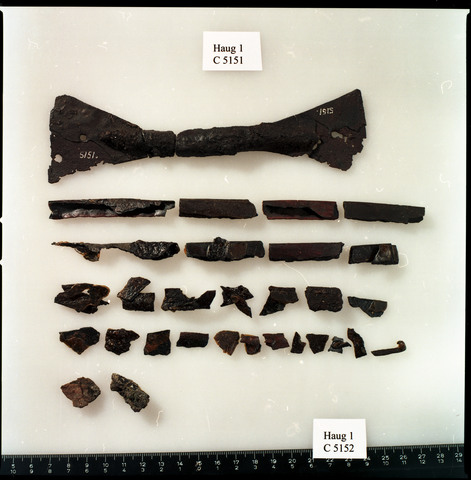
Another irom rim fragment S5678o
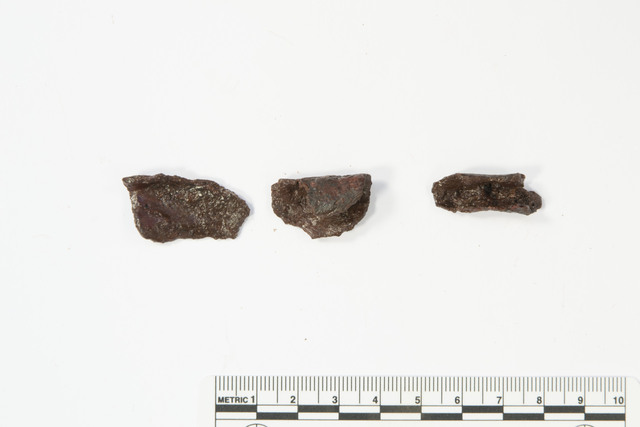
Yet another possible shield iron rim. No dating (migration period dig in Vik, Hove? B1476
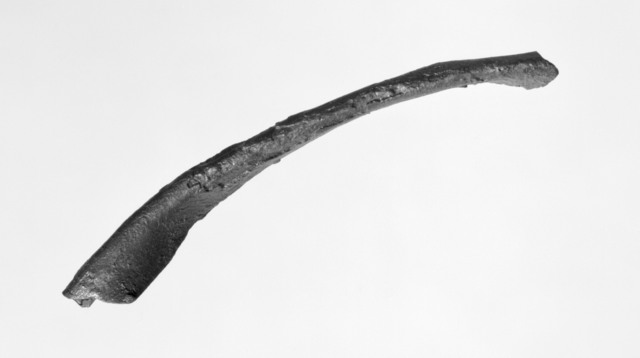 |
|
|
  |
 |
|
|
You cannot post new topics in this forum
You cannot reply to topics in this forum
You cannot edit your posts in this forum
You cannot delete your posts in this forum
You cannot vote in polls in this forum
You cannot attach files in this forum
You can download files in this forum
|
All contents © Copyright 2003-2024 myArmoury.com — All rights reserved
Discussion forums powered by phpBB © The phpBB Group
Switch to the Basic Low-bandwidth Version of the forum
|

